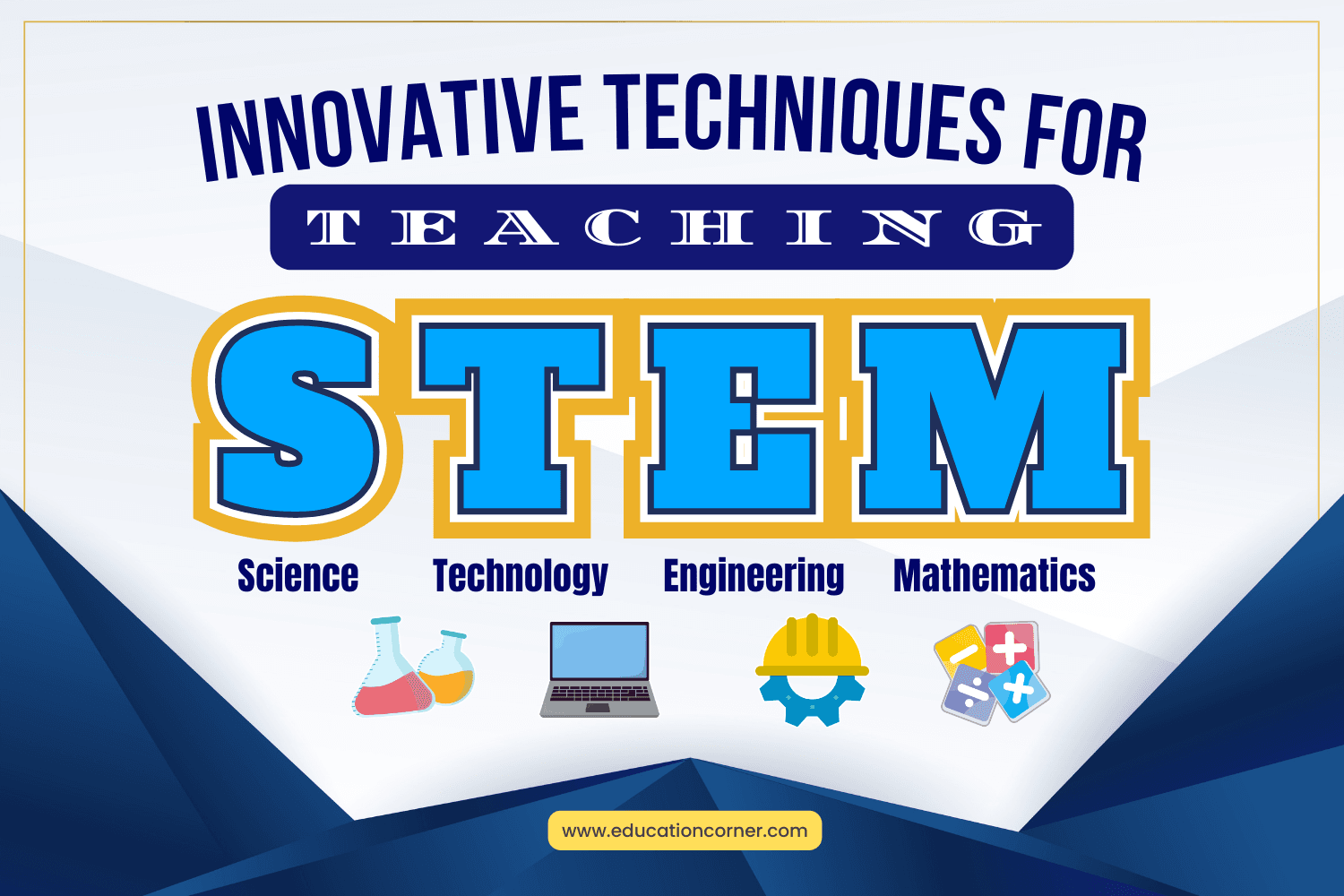As the world races to gain the full productivity benefits of technologies like generative AI, the gap between the knowledge generated in the education system and the skills demanded by employers is widening.
By 2030, the demand for technological skills is expected to rise by more than 50 percent, and the need for complex cognitive skills is set to increase by one-third.
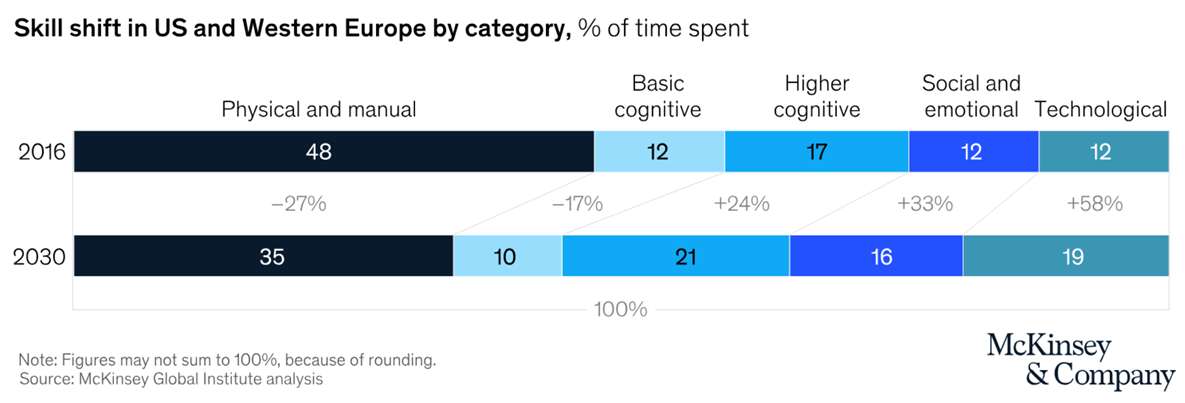
A recent McKinsey survey involving C-suite executives in five countries showed that firms are already grappling with skill shortages, particularly in fields such as programming, data analysis, and mathematics, that require critical thinking, problem structuring, and complex information processing.
Overcoming these limitations will require prioritizing STEM education, which refers to teaching and learning in Science, Technology, Engineering, and Mathematics. STEM typically includes educational activities across all grade levels—from pre-school to post-doctorate—in both formal and informal settings. It prepares students for diverse career opportunities and helps shape a deeper understanding of the world around them.
Because improving the quality and equity of education systems worldwide is more important today than ever, the goal of STEM learning must be to create inquisitive and curious children who, as adults, can apply their understanding to comprehend and address the unanticipated problems of the future.
This article explores five essential higher-order thinking skills for STEM success and outlines four effective teaching practices for cultivating these skills in young learners.
Five higher-order thinking skills in STEM
Young children are emergent engineers, meaning preschoolers, toddlers, and even infants exhibit many foundational skills used in complex problem-solving in engineering design. With the right encouragement, educators can develop their higher-order thinking skills and provide an exciting context for integrated STEM learning.
There are five important higher-order thinking skills (see image), the development of which must be encouraged in young problem solvers. The goal of early STEM education is to enhance these higher-order thinking skills as children engage in emergent problem-solving.
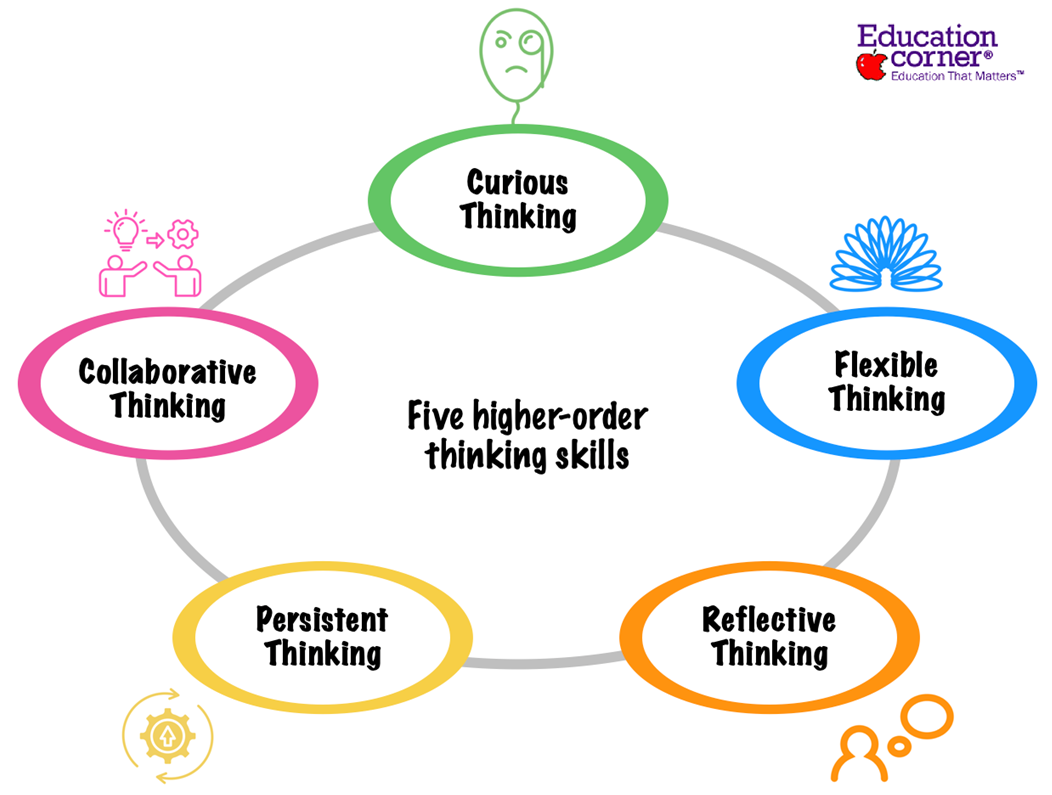
Curious thinking
When determining the goals and constraints of a design problem, engineers consider broad, contextual issues. They spend much time asking questions and gathering information about the problem.
For example, when constructing the iconic Golden Gate suspension bridge in San Francisco, engineers had to deal with geographical challenges, technological limitations, environmental impact, aesthetic considerations, economic feasibility, maintenance and operations, social and cultural factors, safety and reliability, etc.
Engineers use curious thinking to anticipate possible solutions when faced with such situations. Likewise, young children love exploring new objects and environments, and when faced with puzzles about what makes something work, they attempt to solve them through play.
This love of exploration and questioning can be further developed into a curious thinking habit with adult support. Teachers can take the following steps to spark curious thinking in young children:
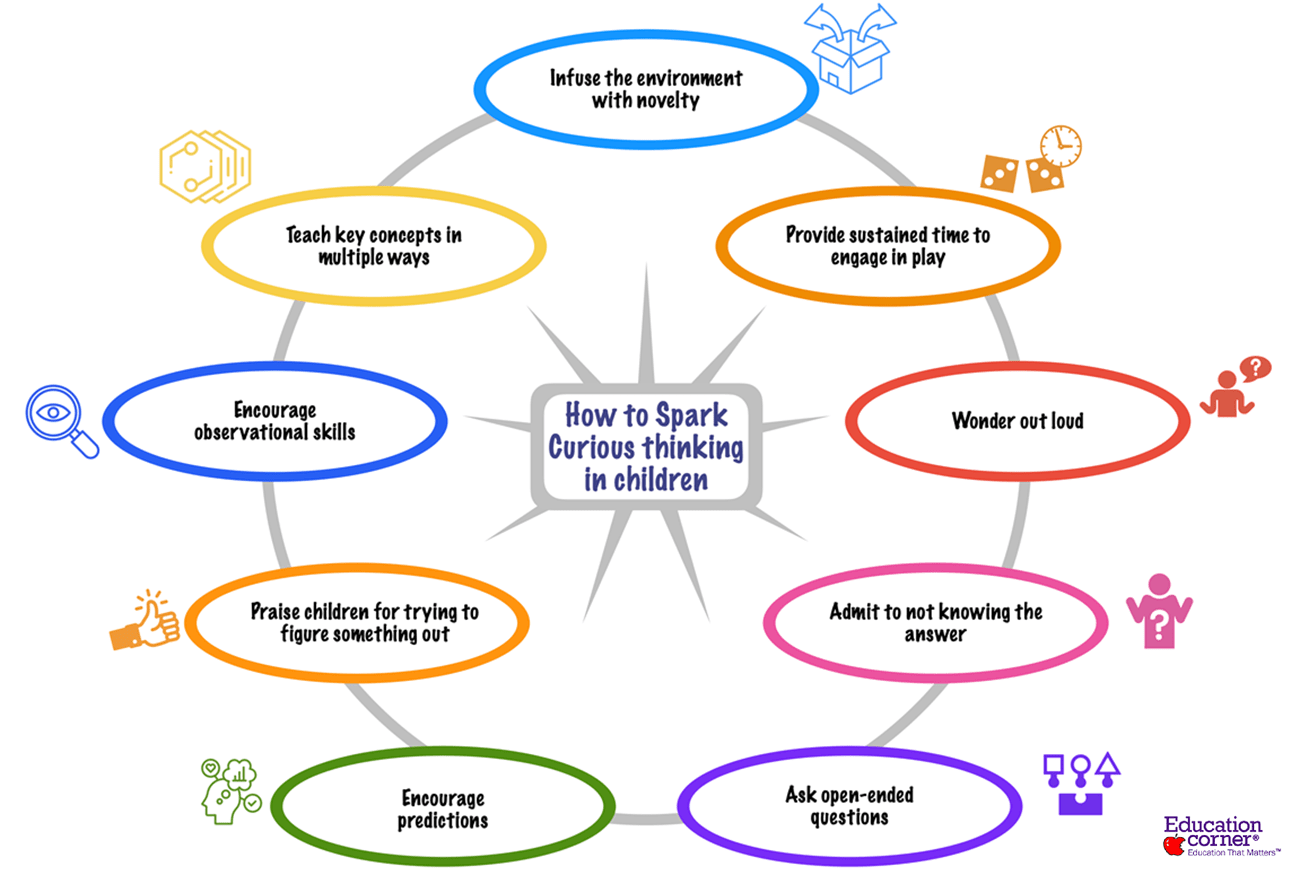
- Infuse the environment with novelty: Always have something new for young children to learn or explore, even if it’s just a new song, story, or object. Nature is rich with opportunities for exploration; consider bringing in seashells, pinecones, or various rocks for kids to examine.
Providing a rich curriculum with new experiences and materials for children to investigate can stimulate curiosity, reduce boredom, and prevent negative behaviors that stem from a lack of stimulation. - Provide sustained time to engage in play. With many transitions, children will not have enough time to think through the problems that arise during play, develop themes for their play, or implement a creative new idea. Provide extended free or loosely structured play periods in which adults follow the children’s lead. This encourages kids to be curious and experiment with new things.
- Wonder out loud: Start activities with a prompt like: “I wonder what would happen if…?” and encourage children to speculate. Model curiosity aloud: “I wonder how that bird can fly,” or when reading a book, “I wonder why the boy in this book looks so sad.” When adults share what they wonder about, it encourages curious behavior in children.
- Admit to not knowing the answer: When adults admit to what they don’t know—and demonstrate their interest in finding out—it teaches children to enjoy the process of learning and discovery. Acknowledge an unexpected question or answer by saying, “Wow, I hadn’t thought of that! We can find that out. Thanks for sharing.”
- Ask open-ended questions: this prompts children to explain their thinking and explore a new combination of ideas. It also keeps the feedback loop open between the child and an adult during an activity. To help the child delve deeper into an idea, encourage many possible answers by asking, “What else could we do?”
- Encourage predictions: making predictions is a way of expressing curious thinking. One way to model and encourage prediction-making is to pose a question and document a child’s response.
For example, when telling a story in a class, ask, “Will a wall solve the gardener’s problem by keeping the bunnies away?” and draw a simple chart with “Yes” and “No” columns. Have each child give their prediction and record them in the appropriate column. Have children count the number of “yes” and “no” predictions. - Praise children for trying to figure something out: be it a friend’s behavior or how something works, positively comment on their curiosity: “I see that you’re trying to figure out why the block tower fell. That’s great—that is how we learn new things!”
- Encourage observational skills: Go on a walk and have the child observe the surroundings. A week or so later, take another walk on the same path and ask the child if they see anything new or different from the last time.
- Teach key concepts in multiple ways: present key concepts in as many ways as possible: visually, through sound, with movement, and so on. The more senses you use, the more likely you will engage every child and spark their curiosity.
For example, the water cycle concept could be taught through (1) visuals using a colorful diagram depicting the stages—evaporation, condensation, precipitation, and collection. (2) by playing a recording (sound) of rain, a bubbling brook, or a waterfall (3) by having children act out the water cycle, pretending to be the sun (evaporation), rise like water vapor (condensation), and then fall to the ground as raindrops (precipitation) (4) Hands-On: through a simple experiment.
This multi-sensory approach to learning can make concepts more engaging and memorable for all students.
Persistent thinking
Persistent thinkers actively take risks, repeat their experiments to verify results, and look for new outcomes. They remain committed for sustained periods to solve or understand the problem better. For young children, persistence is correlated to development and intelligence and is a key predictor of cognitive development.
Persistence is a skill that can be nurtured and grown through responsive and sensitive parenting and caregiving. Parents and teachers play a crucial role in limiting children’s stress and anxiety during learning and play so that children are encouraged to take risks and make mistakes.
Here are some evidence-based ways to encourage persistence in children:
- Do not try to take over the task when it becomes difficult: be patient and wait longer than you think necessary to see if your child can figure it out on their own. Wait until they ask for help to provide any assistance and then provide only verbal assistance in the form of hints or possible next steps.
- Talk through a time that you failed and then succeeded at a difficult task: explain how your hard work and effort helped you to succeed. You can even let children observe you taking on challenging tasks and succeeding (for example, plan to run a marathon or learn a foreign language). Research shows seeing a parent or a teacher exert effort for a difficult task and then succeed makes children more likely to persist themselves.
- Break the challenge into smaller manageable steps: help your child break down difficult or complex tasks into smaller manageable steps or set smaller goals to help them achieve a larger goal.
- Praise their effort as they work through a difficult task: research shows when process praise slightly outweighs personal praise, it leads to the highest levels of motivation and persistence, enhancing a child’s motivation to stick with a difficult task.
- Notice and acknowledge: when a child sticks with a difficult task or shows persistence, acknowledge that they are being persistent.
- Encourage: It is particularly important to encourage children to try activities that are both challenging and enjoyable for them.
Flexible thinking
Flexible thinking (also referred to as cognitive flexibility) allows children to switch gears and look at things differently. It includes the ability to “unlearn” old ways of doing things, learn new ways, and think in multiple ways.
For example, if a pencil has broken, a flexible-thinker child may come up with multiple solutions, such as getting a new pencil, sharpening the pencil, borrowing a pencil, or using a pen. In contrast, one who isn’t a flexible thinker may think there’s nothing he/she can do.
Educators can use the following strategies to help children develop flexible thinking:
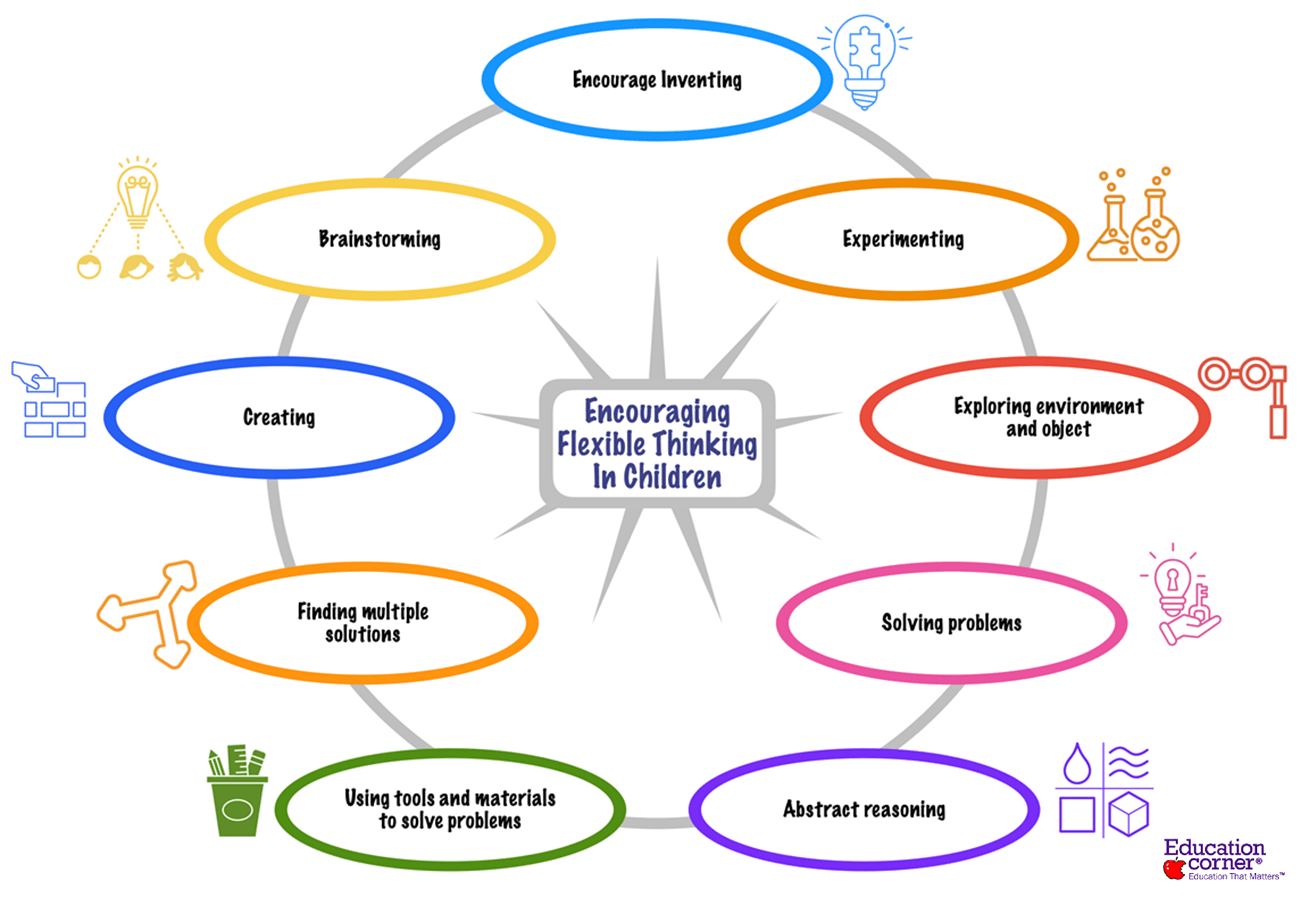
- Encourage inventing: Inventing stimulates students to generate new ideas and create novel solutions. This requires them to think outside the box, make connections between unrelated concepts, and embrace trial and error, all of which build mental flexibility and capacity to innovate.
- Experimenting: this involves testing hypotheses and exploring outcomes through hands-on activities. It promotes flexible thinking by allowing students to learn from failures, adapt their methods, and refine their ideas based on new evidence or results. Here are 40 fun and easy preschool science experiments to try.
- Exploring the environment and objects: exploring surroundings and interacting with different objects helps develop curiosity and observational skills. This fosters a flexible mindset as children learn to see familiar things in new ways and understand the diverse possibilities that the environment offers.
- Solving problems: problem-solving encourages students to tackle challenges by applying various strategies. It enhances flexible thinking by requiring them to adjust their approach when initial attempts fail, fostering resilience, adaptability, and critical thinking skills. Here are some ideas for problem-solving activities in the classroom.
- Abstract reasoning: Abstract reasoning involves thinking about concepts that aren’t directly tied to concrete experiences. This type of thinking enhances flexibility by pushing students to imagine possibilities, generalize from specific instances, and consider multiple interpretations of the same concept.
- Using tools/materials to problem-solve: Utilizing different tools and materials to solve problems teaches students to think resourcefully and creatively. It requires them to adapt their thinking to the constraints and possibilities offered by various resources, thereby promoting flexibility in their approach to challenges.
- Finding multiple solutions: Encouraging students to identify more than one solution to a problem encourages flexible thinking by showing them that there are often several valid ways to approach a challenge. This process helps them become more open-minded and willing to consider diverse perspectives.
- Creating: this involves bringing something new into existence, whether a piece of art, a story, or a scientific model. This act of creation requires students to think flexibly, combine different ideas, and explore new ways of expressing their thoughts.
- Brainstorming: generating a wide range of ideas in a non-judgmental environment enhances flexible thinking by encouraging students to explore all possibilities, including unconventional or seemingly impossible ones, without immediate criticism or dismissal.
Reflective thinking
Reflection is the opposite of reaction. It involves refraining from immediately reacting to an object or event and instead representing it in the mind, remembering it later, analyzing it, and then planning and carrying out your next step.
As society grows more complex, information changes rapidly, prompting people to constantly rethink, switch directions, and change problem-solving strategies. Promoting reflective thinking during learning helps children develop strategies for applying new knowledge to complex situations in their day-to-day activities.
It helps develop higher-order thinking skills by relating new knowledge to prior understanding, thinking in both abstract and conceptual terms, applying specific strategies in novel tasks, and understanding their own thinking and learning strategies.
Educators can encourage reflective thinking by:
- Providing wait time for students to reflect when responding to inquiries.
- Provide emotionally supportive environments in the classroom to encourage re-evaluation of conclusions.
- Prompting to review the learning situation, what is known, what is not yet known, and what has been learned.
- Providing authentic tasks involving ill-structured data to encourage reflective thinking during learning activities.
- Prompting students’ reflection by asking questions that seek reasons and evidence.
- Providing explanations to guide students’ thought processes during explorations.
- Providing a less-structured learning environment that prompts students to explore what they think is important.
- Providing social-learning environments such as those inherent in peer-group works and small-group activities that allows students to see other’s points of view.
- Providing a reflective journal to write down students’ positions, giving reasons to support what they think, and showing awareness of opposing positions and the weaknesses of their own positions.
Collaborative thinking
Collaborating involves coordinating actions to achieve a common goal through social interactions such as expressing, listening to, and contributing ideas. It also involves cognitive tasks, such as integrating information and concepts, remembering prior events, and critiquing ideas.
Collaborative thinking is the primary “social ingredient” of problem-solving. Most real-world problems are solved by groups and teams of individuals working together effectively, asking questions, pooling information, contributing to and critiquing concepts and ideas, and jointly testing solutions.
The skills needed to collaborate in intellectual inquiry processes are complex and require high social and cognitive competencies. Collaborative thinking requires competencies in language and communication, social skills, and critical thinking, while collaborative action requires the integration of these competencies.
Educators can explicitly teach children the skills of working collaboratively with a range of partners using the following steps:
- Build team spirit and encourage a culture of cooperative behaviors by promoting a ‘we can’ attitude.
- Lead by example, modeling collaborative behaviors with staff and children.
- Minimise clutter and create flexible working spaces where children can work together.
- Explicitly teach the skills for collaboration so children understand the importance of individual contributions and take responsibility for their actions when working with others.
- Create visual cue charts with children, focusing on the positive behaviors expected in group work.
- Include informal and formal reflections about working collaboratively in groups to increase children’s awareness and understanding of the processes involved. Ask questions such as:
– How well do you think your group worked today?
– How do you know you/your group worked well?
– What is one thing you think you did really well to help your group?
– What is something you would like to do better next time?
Teachers can also induce cooperative learning to encourage collaborative thinking among young students. Here is a more detailed guide on incorporating collaborative learning in the classroom.
Effective teaching practices in STEM
Although four disciplines are included in the acronym STEM, science and mathematics are the most familiar to teachers of young children. Yet many early childhood teachers fail to capitalize on the science opportunities embedded throughout the classroom. Adult support is critical if young children are to maximize their foundational learning.
For example, most preschool classrooms incorporate water wheels in the sensory table, and children delight in watching the wheels spin as they pour water through them. Yet most children won’t consider the relationship between the amount of water they pour and how fast the wheel spins unless an adult is there to stimulate this thinking.
Many early childhood teachers do not consider themselves math teachers, even though mathematics is a critical curriculum component. They may feel uncomfortable with math; their math anxiety often dates back to their own elementary school experiences. While teachers may count objects with children or read counting books, they often do not engage in math discussions and problem-solving activities that expand thinking.
Because engineering is a profession pursued in college, it seldom occurs to teachers to connect children’s activities to real-life engineering jobs. When children design and build block structures, they must know that this is also what architects and engineers do.
Four teaching practices are critical to early learning in STEM:
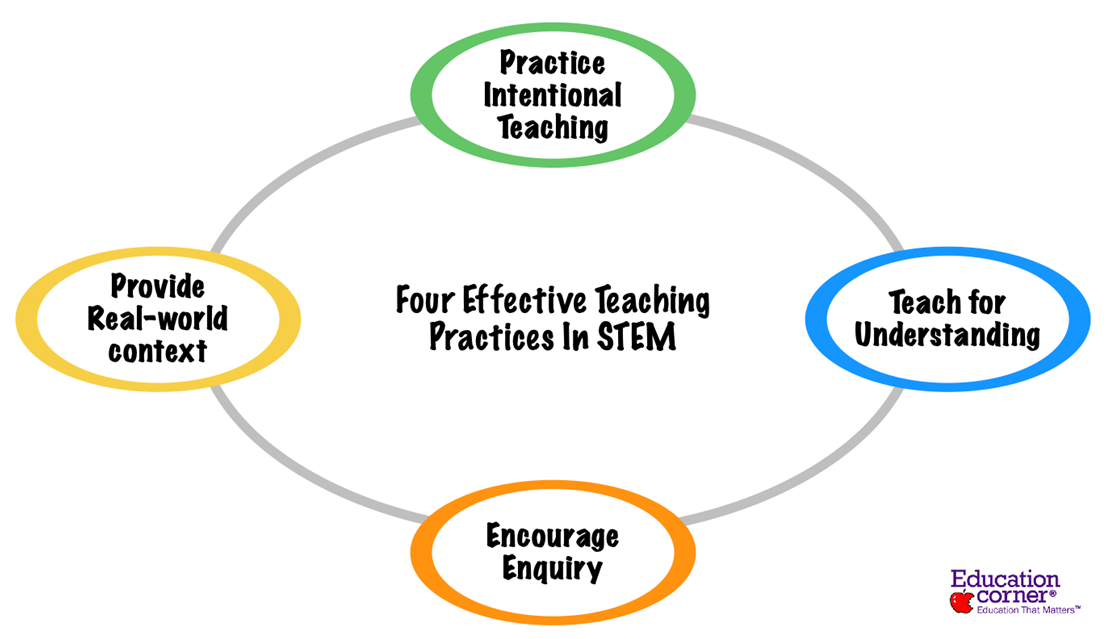
Practice intentional teaching
Intentional teaching requires teachers to thoughtfully plan learning experiences with STEM goals in mind. They must be purposeful and deliberate in their decisions and actions when planning for children’s learning and development. Intentionality also comprises applying a child-centered approach that encourages children’s exploration.
Educators act with intentionality in play-based learning when they:
- Extend children’s learning using intentional teaching strategies, such as asking questions, explaining, modeling, speculating, inquiring, and demonstrating. This extends children’s knowledge, skills, and enjoyment of thinking and learning.
- Sustain, extend, challenge, and deepen children’s ideas and skills through shared thinking and scaffolding learning.
STEM education involves disciplines where individuals must ask questions, establish relationships, and communicate ideas. For this reason, a focus on inquiry should be at the heart of education. The following strategies can be used to facilitate intentional teaching:
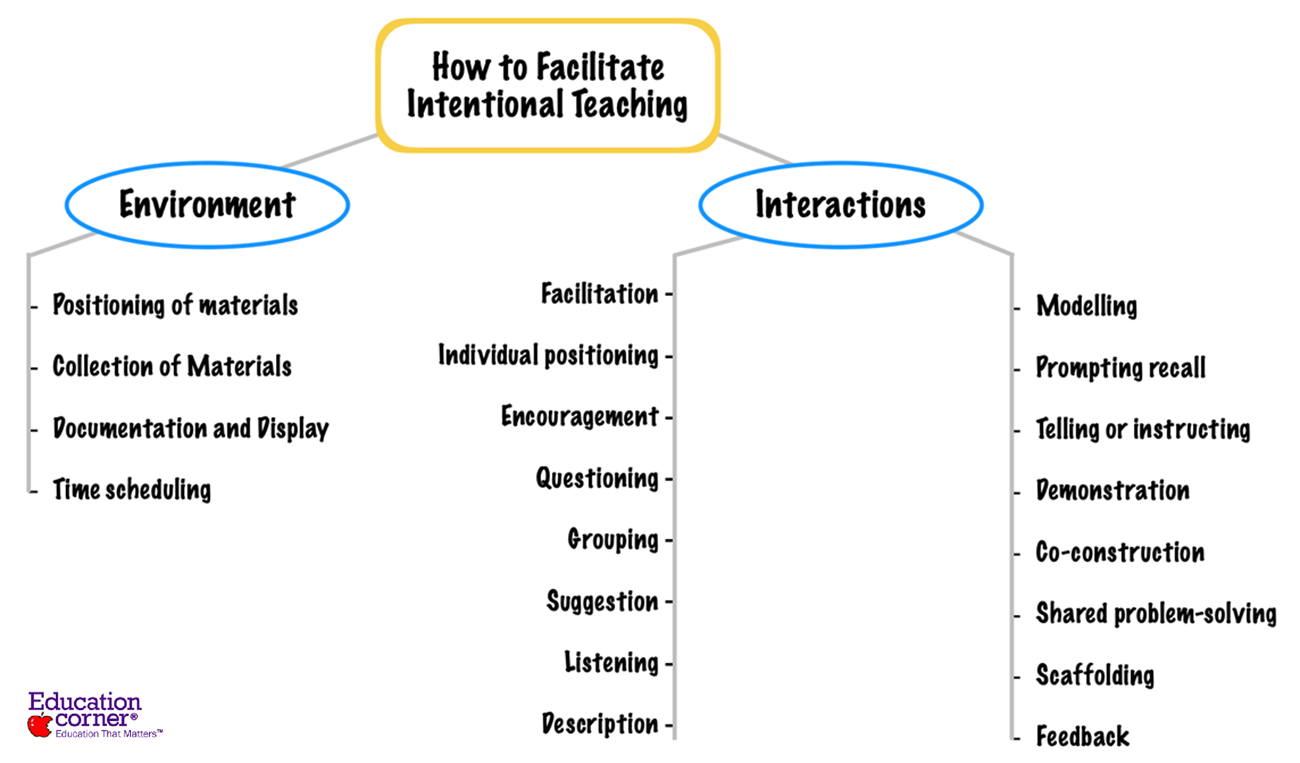
Educators must also be intentional about the environment to be intentional in teaching. The following strategies can be used:
- Positioning materials: strategically arrange objects to shape the learning environment and guide children’s interactions. For example, placing a child’s favorite toy in an area with science toys can prompt them to integrate it into their activities, thus extending their role-play and encouraging broader participation.
- Collecting materials: Use a collection of materials to intentionally encourage children’s sensory exploration and support their knowledge and skills. For example, play dough (various colors), rolling pins, cookie cutters, and small containers can stimulate young children’s sensory development, creativity, and imagination.
- Documentation and display: documentation can be created to provide children with a written or pictorial record of previous experiences and learning that can support them in revisiting or extending that learning. Use documentation and display intentionally to develop and deepen children’s interest, support their understanding of learning, and help build communities of learners.
- Scheduling time: scheduling can intentionally prioritize and extend select learning activities and make time for experiences and interactions. This helps organize time to support children’s changing interests and levels of concentration and energy, ensuring a balance of activity and experiences across the curriculum, getting involved with children, or having in-depth conversations.
Intentional teaching interactions can be planned by using the following strategies:
- Encouragement: reassuring and supporting a child when they face difficulties. This motivates learning, transforms frustration into satisfaction, and encourages children to persist with tasks and explore new ideas.
- Facilitation: making the children’s learning process easier by thoughtfully and intentionally using equipment, time, materials, space, and interactions helps children become independent learners, promotes social and cooperative play, and boosts confidence.
- Positioning: Intentionally placing yourself near individuals, groups, or objects can enhance children’s learning and foster active engagement. Eye contact, smiles, and physical closeness can create a warm learning environment that encourages participation and focus.
- Grouping: deliberately organizing children into groups can support their learning, foster cooperative skills, enhance cognitive development through idea exchange, and enable peer scaffolding between children with different capabilities.
- Listening: genuine listening involves focusing on what children say and express through non-verbal cues. Use listening to encourage children to share their ideas and experiences, inform your decisions on when to intervene in play, and gain insights into their interests to guide curriculum development.
- Description: using language to help children notice and understand how something looks, feels, sounds, tastes, or moves. This helps them make complex distinctions and enhances awareness of various properties and characteristics.
- Modeling: models are ubiquitous representations of objects, ideas, concepts, systems, events, and processes. They help describe, explain, construct, and predict phenomena by organizing relevant information, generating hypotheses, and explaining how information may be related.
Models communicate a simplified reality through concrete, conceptual, and formal/symbolic depictions (e.g., a spaceship blueprint or diagram of a bacteria). This research paper discusses models and modeling in STEM education in more detail. - Demonstration: involves modeling a task, breaking it down into steps, and using clear, unambiguous language to describe your actions. This is most successful when it is brief and children have plenty of opportunities to practice.
- Questioning: questions are used to seek information or an increased understanding of something or someone. They help determine what children think about and how they make sense of the social and natural world. Use questions intentionally to excite interest in an event, information, or object, provoking thought and curiosity and initiating learning about it.
- Suggestion: offer children advice, ideas, and recommendations about the next steps. Give them the option to follow or not. Direct their attention to salient features of a problem and enrich storylines during learning and play.
- Telling or instructing: involves using a verbal account or description to explain what is happening or what should happen. While this allows little opportunity for children’s participation, when used intentionally, it can support learning in specific situations, such as supporting children’s safety using equipment, reducing frustration or embarrassment, or developing independence in using a new tool or technique.
- Prompting recall: Ask children to recall or remember something with questions such as, ‘What happened when you tried that?’ or ‘What do you remember about…?’ Recall can be used intentionally to help children solve problems, reinforce ideas, concepts, and knowledge, or support them in reporting on their experiments and observations. This helps develop concentration and memory.
- Feedback: Feedback can be either verbal (a comment on how the child approached the task) or nonverbal (a smile to show appreciation for the child’s efforts). It encourages children in what they are doing and provides pointers about what to do in the future.
Use feedback intentionally to reinforce aspects of children’s learning behaviors positively, encourage children to persist with difficulty, develop self-efficacy and confidence, and support children in understanding themselves as learners. - Scaffolding involves helping a child become more competent by offering temporary guidance and support. It draws on a combination of teaching techniques: questioning, encouraging, prompting recall, describing, suggesting, and modeling.
Scaffolding can be used intentionally to develop children’s skills and capabilities, particularly those just emerging or slightly above the child’s current level of competence, and to shape children’s construction of knowledge about a phenomenon or experience. - Shared problem-solving: educators must intentionally work with children in joint problem-solving. This involves shared attention and understanding to develop initiative, creativity, and thinking skills that develop confidence and encourage collaboration.
- Co-construction: involves forming meaning and building knowledge about the world in negotiation with children. It emphasizes listening and understanding the meaning of objects and events for children rather than transmitting facts.
Use co-construction intentionally to teach children how to problem-pose and problem-solve with others, emphasizing that there are multiple ways of explaining and representing the world or many ways to explore a problem or phenomenon.
Teach for understanding
Knowledge and skill have traditionally been the mainstays of education. Children are expected to be knowledgeable in history, science, geography, etc., and skillful in arithmetic, writing, and language use. While achieving this is not easy, they work hard at it.
Students garner knowledge and skills in schools so that they can put them to work in professional roles such as scientists, engineers, designers, and doctors, which require appreciation, understanding, and judgment.
Knowledge and skill in themselves, however, do not guarantee understanding. Students can acquire knowledge and routine skills without understanding the basis or when to use them. And when knowledge and skills are not understood, they do students little good.
What is understanding?
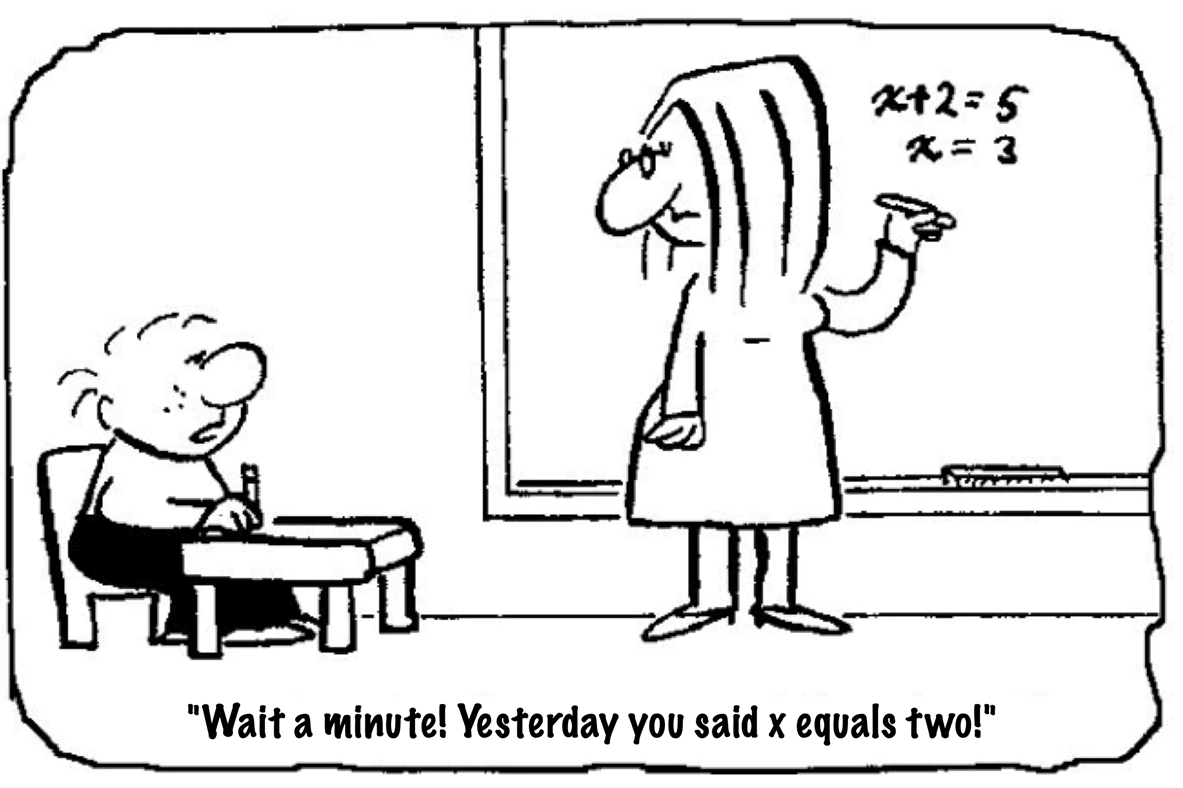
Understanding a topic of study is a matter of being able to perform in various thought-demanding ways with the topic, for instance, to explain, muster evidence, find examples, generalize, apply concepts, analogize, represent in a new way, and so on.
Suppose a student “knows” Newtonian physics. The student may write and apply equations to three or four textbook problems. This alone is not convincing evidence of understanding. The student might simply parrot the test and follow memorized routines for stock problems.
If the student can make appropriate predictions about projectiles in space (such as what effect throwing a snowball will have on an astronaut in space), this goes beyond just knowing. Moreover, if the student can find new examples of Newton’s theory at work in everyday experience (for example, why do football linemen need to be so big) and make other extrapolations, this goes beyond just knowing.
The more thought-demanding performances a student can display, the more confident educators can be that the student understands.
How to learn with understanding
How do children learn to skate? Certainly not just by reading instructions and watching others, although this might help. They learn by skating. If they are good learners, they learn not just by idle skating but by thoughtful skating, where they pay attention to what they are doing, capitalize on strengths, figure out weaknesses, and work on them.
It’s the same with understanding. The mainstay of learning for understanding is engagement. Learners must spend significant time with activities that ask them to find new examples, generalize, carry out applications, and work through other understanding performances. This must be done thoughtfully, with appropriate feedback to help perform better.
Traditional classrooms often overlook the importance of active engagement in understanding performances. True understanding requires processing and reflecting on information and continually refining thinking to form flexible and accurate connections.
How to teach for understanding
From an educator’s perspective, teaching for understanding is not overly difficult but requires intricate classroom management. There are six priorities to follow:
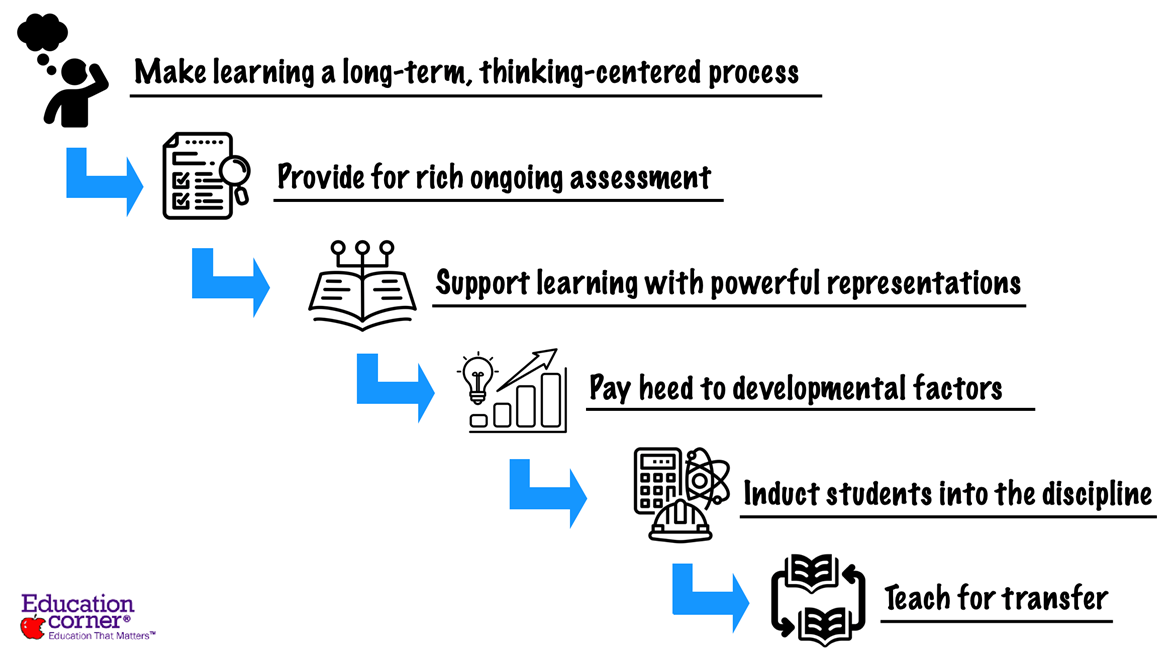
- Make learning a long-term, thinking-centered process: teaching must be less about what the teacher does and more about what they get the students to do. Teachers must arrange for students to think with and about the ideas they are learning for an extended period of time so they learn their way around a topic.
Unless students spend significant time thinking about and applying the ideas they learn, they are unlikely to develop a versatile understanding. A long-term, thinking-focused process is crucial for building understanding. - Provide for rich ongoing assessment: traditionally, assessment comes at the end of a topic and focuses on grading and accountability. While important, this does not serve students’ immediate learning needs.
To learn effectively, students need criteria, feedback, and opportunities for reflection from the beginning of any sequence of instruction. Occasions of assessment should occur throughout the learning process from beginning to end. This could involve feedback from the teacher, peers, and sometimes self-evaluation. While there are many reasonable approaches to ongoing assessment, the constant factor is the frequent focus on criteria, feedback, and reflection throughout the learning process. - Support learning with powerful representations: how information is represented can influence enormously how well that information supports understanding. For instance, conceptual models, in the form of diagrams with accompanying storylines, can help students solve nonroutine problems requiring the application of new ideas.
Many of the conventional representations employed in schooling—for instance, dictionary definitions of concepts or notational representations such as Ohm’s law, I = E/R—leave students confused or only narrowly informed.
The teacher teaching for understanding must add more imagistic, intuitive, and evocative representations to support students’ understanding performances. In addition to supplying powerful representations, teachers must often ask students to construct their own representations. - Pay heed to developmental factors: The seminal developmental psychologist Jean Piaget asserted that children’s understanding is limited by the general schemas, a mental pattern they develop to understand their world. Based on this, many teachers believe that fundamental reasoning and understanding are lost on children until late adolescence.
However, more recent research has forced fundamental revisions in the Piagetian conception, demonstrating that under supportive conditions, children can understand much more than was previously thought.
The picture of intellectual development emerging today is less constrained, more nuanced, and ultimately more optimistic regarding education prospects. Teachers teaching for understanding must consider factors like complexity without rigid conceptions of what students can and cannot learn at certain ages. - Induct students into the discipline: Concepts and principles in a discipline are not understood in isolation. Grasping what they mean largely depends on recognizing how they function within the discipline. All disciplines have ways of testing claims and mustering proof, but how that’s done varies.
For example, experiments can be conducted in science, but in history, evidence must be mined from historical records, and in mathematics, we justify a theorem by formal deduction from the givens.
Conventional teaching introduces students to facts, concepts, and routines, but it typically does much less to awaken students to how the discipline works. A teacher teaching for understanding must undertake an extended mission of explicit consciousness-raising about the structure and logic of the disciplines being taught. - Teach for transfer: research shows that young students are not particularly good at carrying over facts and principles from one context to another. For example, they fail to use the math they learned in a math class and apply that to a science class or at the supermarket.
Knowledge tends to get glued to the narrow circumstances of initial acquisition. Hence, teachers must teach explicitly for transfer, helping students make the connections they otherwise might not make and cultivating mental habits of connection-making.
Encourage Inquiry
At its broadest, inquiry-based learning is an active form of learning that centers around asking students questions or presenting them with problems and scenarios they must resolve.
Research suggests that inquiry-based learning helps students become more creative, positive, and independent. It provides opportunities to develop life skills, learn to cope with problems that may not have clear solutions, deal with changes and challenges to understanding, and shape children’s search for solutions, now and in the future.
Using an inquiry model helps students internalize the process for inquiry that is transferable to everyday life situations. It consists of six steps:
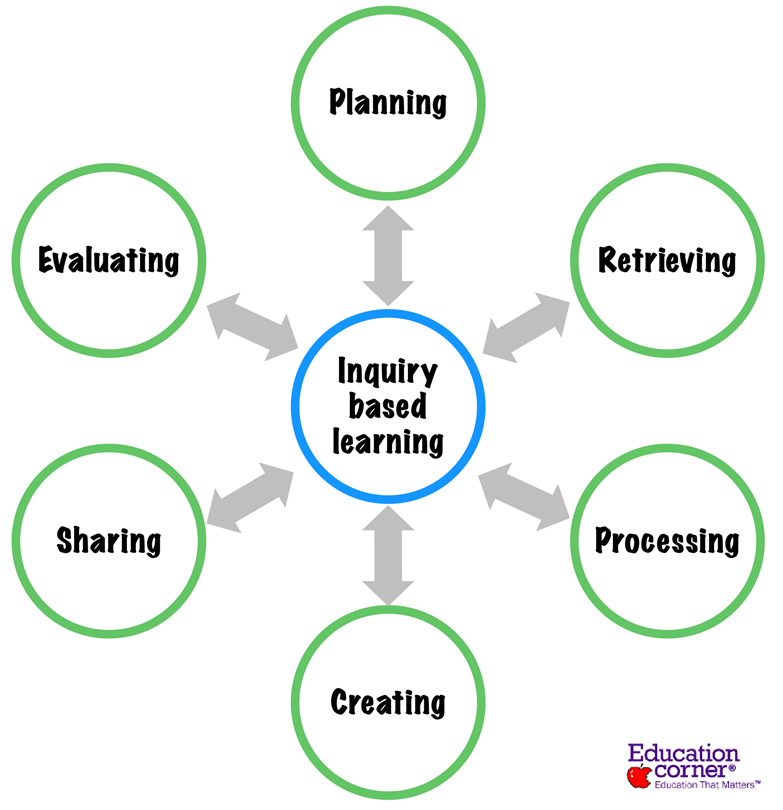
- Planning: this is the most important phase of the whole process, where students understand that the purpose of inquiry-based learning projects is to develop their “learning to learn” skills. This begins with their curiosity about a topic—the puzzle that needs to be solved.
- Retrieving: In this phase, students think about the information they have and the information they want. They may need to spend time exploring and thinking about the information they find before they come to a “focus” for their inquiry.
This pre-focus phase is initially enjoyable for students as they actively search for information related to their topic. However, as the number of resources they find increases, students may have difficulty finding data specific to their topic.
Teachers can help students through this phase by emphasizing that feelings of frustration are normal and teaching them skills and strategies for selecting relevant information and how to adjust and modify inquiries. - Processing: This phase begins when the student has found a focus for the inquiry—an aspect of the topic area that the student decides to investigate. It involves more than just narrowing the topic. It involves arriving at an authentic question, a personal perspective, or a compelling thesis statement.
Students usually experience a sense of relief and elation when they have established a focus for their inquiry. Even so, choosing pertinent information from resources is a difficult task. There may be too little or too much information, or the information may be too superficial or too in-depth. Often, students find confusing or contradictory information and can feel overwhelmed. - Creating: The creating phase involves organizing the information, putting it into one’s own words, and creating a presentation format. Students often feel more confident at this phase and may want to include all their new learning, resulting in too much information. Teachers should help students stay focused in their presentations.
- Sharing: If students have been given enough support throughout the inquiry process, they are usually proud of their product and eager to share it, regardless of the format or audience. They may feel a bit nervous about presenting something they take such ownership of and feel anxious that others may not understand or appreciate their efforts. Nevertheless, they generally feel that they have done well.
- Evaluating: when a research project is complete, students generally feel relieved, happy, and excited about their new skills and understandings. In order to make sense of the inquiry process, they need to evaluate their inquiry process and product, understand and question the assessment criteria their teacher has used, reflect on teacher feedback, and share their feelings about the process.
Provide real-world contexts
Young children learn best when activities are relevant to their lives. Particularly in STEM, young children must have real materials to explore because they still struggle to determine the difference between reality and fantasy at the preschool and kindergarten stages.
Here are some ways teachers can provide real-world contexts for young children when teaching STEM:
- Use everyday objects for exploration and experimentation: incorporate items like kitchen utensils, toys, plants, rocks, and household materials that children are familiar with.
- Connect activities to children’s experiences: for example, when teaching about weather, relate it to how children dress for different conditions or how weather affects their outdoor playtime.
- Conduct nature walks and outdoor observations: take children outside to observe plants, insects, weather patterns, and natural phenomena firsthand.
- Use building and construction materials: provide blocks, LEGO, cardboard boxes, and other materials that allow children to design and build structures they see in their environment.
- Use technology: Teachers can now deploy a range of technologies in the classroom using basic hardware, such as smartphones, which are powerful enough to support most applications. Learn more about how to use technology in the classroom effectively.
- Solve real problems: present children with age-appropriate challenges they might face, like how to keep ice cream from melting or how to make a paper airplane fly farther.
- Invite community members to share their STEM-related jobs: this could include visits from doctors, engineers, or scientists to explain how they use STEM in their work.
- Use storybooks featuring real-world STEM applications: read books that showcase how STEM is used in everyday life and various professions.
- Incorporate practical measurements: have children measure their height, the distance they can jump, or ingredients for a recipe.
- Explore simple machines: demonstrate how pulleys, levers, and inclined planes work using playground equipment or toys.
By grounding STEM activities in real-world contexts, teachers can make learning more relevant, engaging, and meaningful for young children, helping them better understand and apply STEM concepts in their daily lives.

